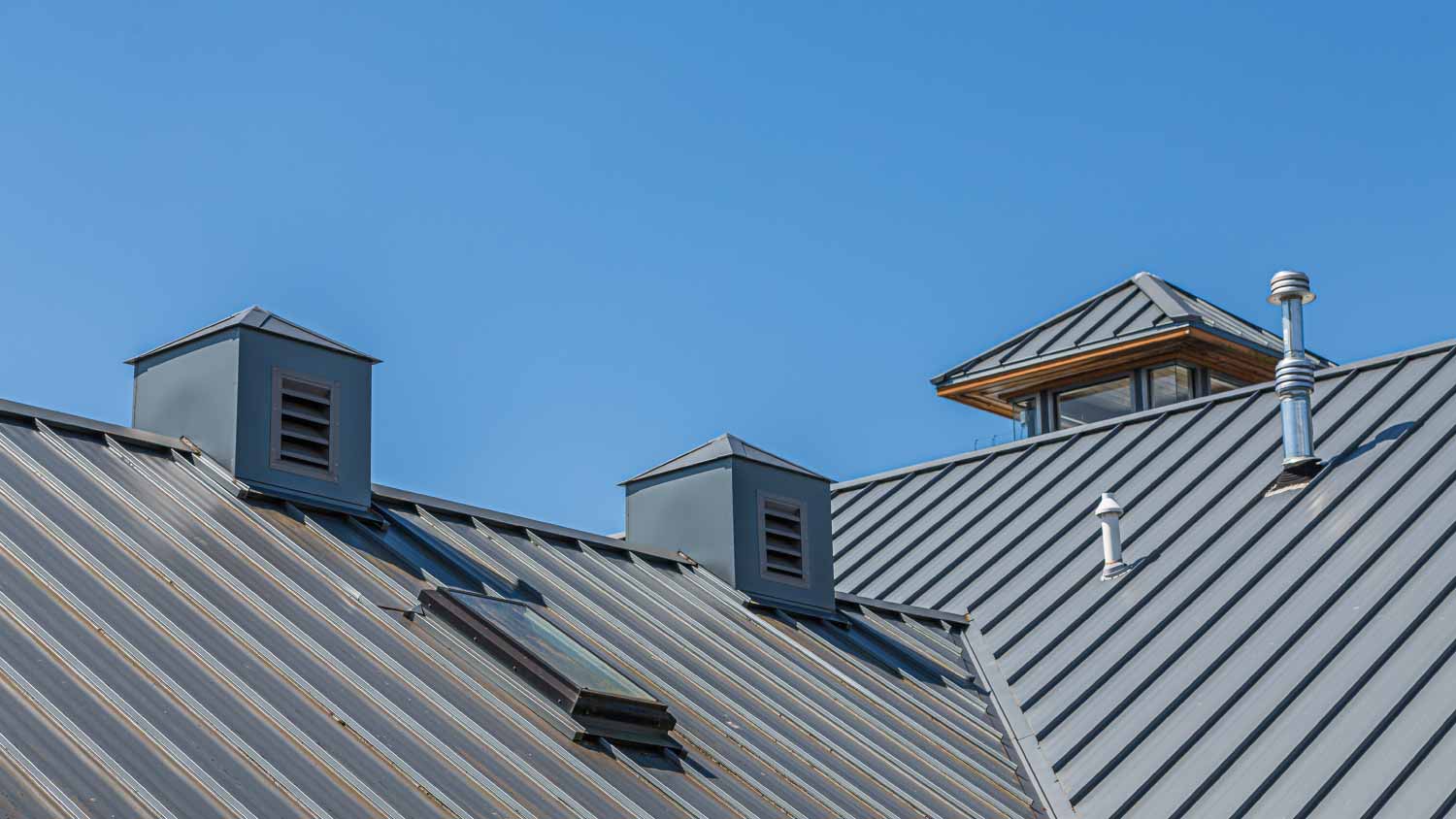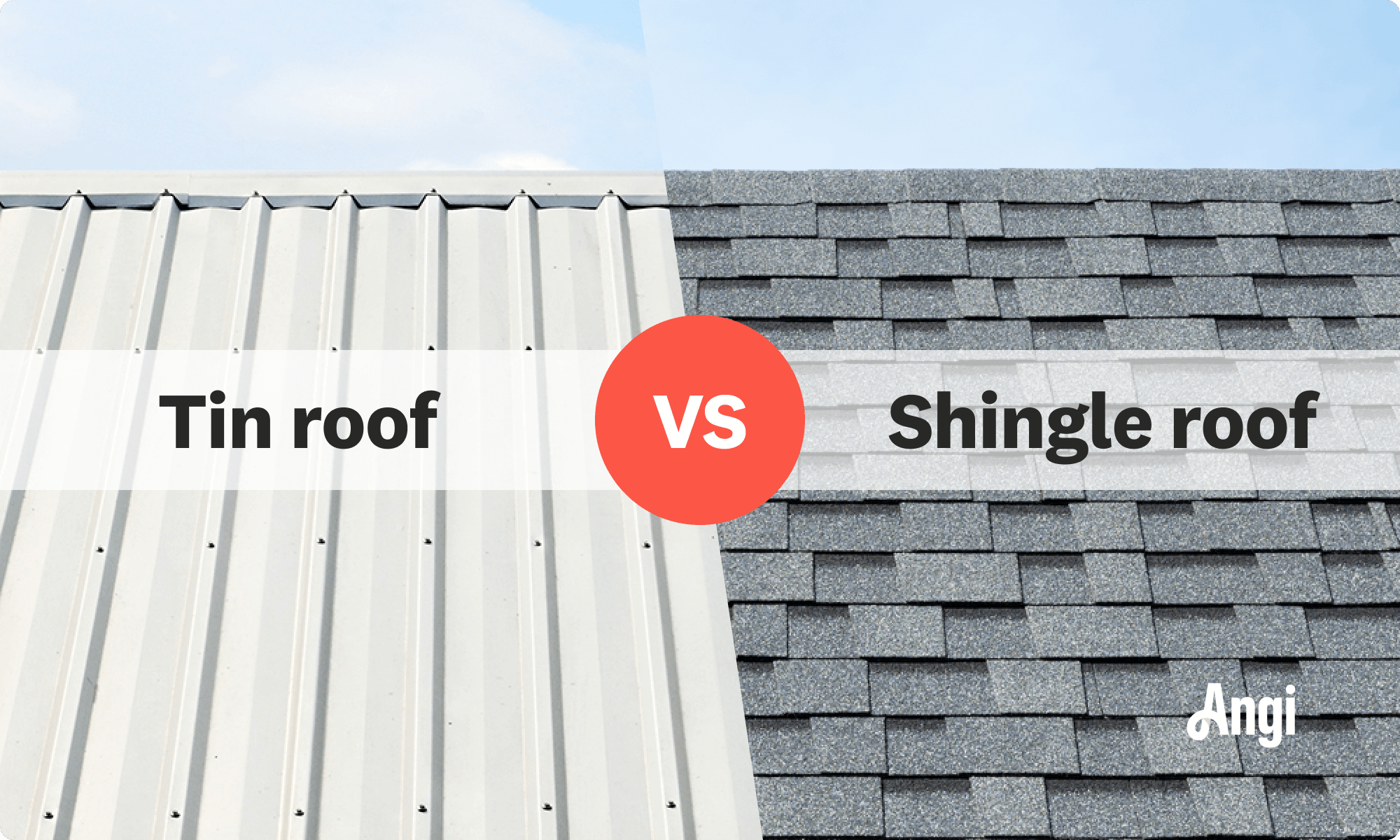
A metal roof can defend your home against Ohio’s varying weather conditions. Learn how much a metal roof costs in Columbus, OH.
Durability and budget go head-to-head


Tin roofs are more expensive than shingles but last more than twice as long.
Shingles offer more customization and design options than tin.
Tin roofs are more energy-efficient in hot climates but less energy-efficient in cold climates.
Choosing the ideal roofing material for your home can have a significant impact on your roof’s functionality and aesthetic appeal. The right roof material for your home depends largely on your climate and budget, which may leave you wondering about the differences between a tin roof and shingles. Let’s explore everything you need to know to make the most informed decision.
Tin roofs are double the price of asphalt shingle roofs, but you get more than double the lifespan and won’t have as much roof maintenance to worry about. They reflect sunlight better, so they can help keep your home naturally cool in hot, sunny climates. Shingles, commonly made from asphalt, are less expensive initially but have a shorter lifespan than tin roofs and require more maintenance. Asphalt shingles are more insulative, which means lower heating costs in colder climates. While shingles offer a classic look and are easier to install, tin roofs provide better longevity, though that comes at a higher up-front cost.

A tin roof is a type of metal roofing made from tin-coated steel or iron sheets. It’s known for its durability, weather resistance, and longevity. Traditionally, tin roofs were widely used in agricultural and rural buildings, but they have since gained popularity in residential and commercial settings due to their strength and energy efficiency.
| Pros | Cons |
|---|---|
| Durable | Higher up-front cost |
| Low maintenance | Noisy |
| Reflect sunlight | Prone to denting |
| Eco-friendly | Fewer design options |
Best for:
Homeowners look for long-term durability
Hot, sunny climates
Homeowners looking to maximize curb appeal
One of the most significant benefits of tin roofs is their exceptional durability. How long does a tin roof last? Tin roofs last an average of 50 years but can push to 80 years with proper maintenance. This longevity means fewer replacements over time, saving money in the long run despite the higher up-front cost. Most homeowners prefer the look of metal roofs, so a metal roof can add more to your home’s value and curb appeal than asphalt shingles.
Another major pro of tin roofs is their energy efficiency in hot climates. Tin's reflective nature helps to reduce solar heat gain, keeping buildings cooler during hot weather and reducing reliance on air conditioning. This can lead to significant savings on energy bills, especially in warmer climates.
Tin roofs are also environmentally friendly, as they are often made from recyclable materials, are recyclable, and contribute less waste due to their long lifespan.
Tin roofs cost between $5 and $12 per square foot, so this type of metal roof costs two to three times as much as an asphalt shingle roof. This can be a barrier for those on a tight budget, though the long-term savings on maintenance and energy costs can offset this initial investment over time. Additionally, asphalt shingle roofs are, by far, the most common option in the U.S., so you may have a harder time finding a local metal roofing installer who can install a tin roof.
Tin roofs can amplify the sound of rain and hail and are also prone to dents from hail or falling branches. They also expand and contract with temperature changes, which can cause fasteners to loosen. As such, they’re not ideal in areas where extreme temperature fluctuations are possible.

Roof shingles are a popular roofing material commonly made from asphalt. The roofer you hire will lay them in overlapping rows to cover the roof. Asphalt shingles are known for their affordability, ease of installation, and wide range of styles and colors.
| Pros | Cons |
|---|---|
| More affordable | Shorter lifespan |
| Easier to install | More maintenance |
| Easier to repair | Higher leak risk |
| Variety of styles | Environmental impact |
Best for:
Budget-conscious homeowners
Homes in colder climates
DIY-enthusiasts
Shingles are popular for their affordability and versatility. One of the biggest advantages is their cost-effectiveness, as the cost to shingle a roof ranges between $1.50 and $6 per square foot.. Shingles offer a variety of styles, colors, and textures, allowing homeowners to customize their roof’s appearance to match their home’s design.
Shingles are easy to install, potentially reducing labor costs and making the process quicker than more complex roofing materials. They’re also more widely available from home improvement stores, and they’re a better option if you plan to DIY your roof installation.
A roofer can easily replace individual shingles, making repairs more straightforward and cost-effective. This is particularly advantageous in regions prone to occasional storms or high winds, where only a few shingles might need replacing rather than replacing an entire tin panel.
The many factors that play into choosing a roofing material may surprise you, such as durability, cost, style, and the climate in which you live. Many homeowners choose asphalt, but there are various types on the market. A roofer can advise you on the best materials for your home and region.
The biggest disadvantage of using shingles is their short lifespan, which is only 20 to 30 years. This means the material may require more frequent replacements than tin roofing, leading to higher long-term costs.
Shingles also have environmental considerations, as asphalt shingles are made from petroleum products and are not easily recyclable. This contributes to a larger environmental footprint compared to more sustainable roofing materials.
Shingles are prone to weather-related damage, such as curling, cracking, or missing pieces from high winds, hail, or extreme temperatures. The material also offers lower fire resistance compared to materials like metal or tile, which can be a concern in areas prone to wildfires.

There are a few key things to consider when deciding between a tin roof and a shingle roof.
The choice between each material depends on personal preference and the home's architectural style, but most homeowners prefer the look of metal roofing. The appearance depends on the type of metal roof you install, so go with a standing seam tin roof for maximum curb appeal.
Shingles come in a wide variety of colors, styles, and textures, giving you more room to customize than with a tin roof. Homeowners can choose from different patterns, such as architectural, three-tab, and luxury shingles, to match the roof's appearance to the home's design. Shingles also come in various materials, including asphalt, wood, and fiberglass, each with different aesthetic properties. You can even go with metal roof shingles for improved curb appeal and customization.
Tin roofs are known for their longevity, lasting for up to 80 years. The material is highly resistant to extreme weather conditions such as heavy rain, snow, and high winds, too. It is also less prone to issues like cracking or curling, which can affect shingles over time.
Shingles are less expensive up front than tin roofs due to the lower cost of materials and installation. Asphalt shingles, in particular, are one of the most affordable roofing materials available. Although asphalt shingles don’t last as long, you could still get more long-term value out of them due to the low installation cost, depending on the climate in your area.
The installation process for shingles is straightforward, and the individual pieces are smaller and lighter, so it’s easier to DIY this type of roof. You’ll also never have an issue finding a local roofer who can install them, as they’re the most common roofing material in the country.
When a shingle is damaged or missing, a roofer can replace individual shingles quickly and inexpensively. This ease of repair is particularly advantageous for minor damage caused by weather or wear and tear. In contrast, metal roof repair often requires replacing an entire panel.
Tin roofs' durability and weather resistance mean they require less frequent upkeep, as they are less prone to issues like cracking, curling, or missing pieces. As a result, maintenance will be almost non-existent.
Tin roofs are often made from recycled materials, and their long lifespan reduces the frequency of roof replacements, contributing to less waste over time. Tin is also recyclable with no loss of material quality, so manufacturers can reuse tin panels many times over. Asphalt shingles are recyclable, but only once.
The durability, longevity, and modern appearance of tin roofs can make a property more attractive to potential buyers. Tin roofs can also appeal to buyers looking for energy-efficient and low-maintenance solutions.
A good place to start to decide which roofing material is best for your home is your climate. If you live in a hot, sunny climate, a tin roof will reflect more sunlight and reduce cooling costs. It’s also a better option in areas that see heavy snowfall, as slick metal sheds snow more readily and reduces the risk of structural damage from heavy accumulation. Asphalt shingles provide more insulation, though, and they can reduce heating costs in cold climates.
You should also think about the up-front cost and long-term value you’ll get from your roof. Go with asphalt shingles if you want a more budget-friendly roof replacement cost, but consider a tin roof for fewer maintenance costs, less frequent replacements, and maximized curb appeal and home value.
From average costs to expert advice, get all the answers you need to get your job done.

A metal roof can defend your home against Ohio’s varying weather conditions. Learn how much a metal roof costs in Columbus, OH.

Dealing with a visibly damaged roof or leak? Learn about roof repair costs in Columbus to see how much you’ll need to budget for a permanent solution.

Learn about roof replacement costs in Columbus and what factors are at play to budget accurately and make sure you’re getting a fair price.

Furring strips support your metal roof and improve ventilation, but only if spaced correctly. Here’s the ideal spacing of furring strips for metal roofs.

Dormer additions are both stylish and practical. Check out how to increase your attic's living space while boosting your home's curb appeal.

Soft spots on your roof can indicate underlying damage. Learn how to identify soft spots, what causes them, and why it’s so important to repair them quickly.